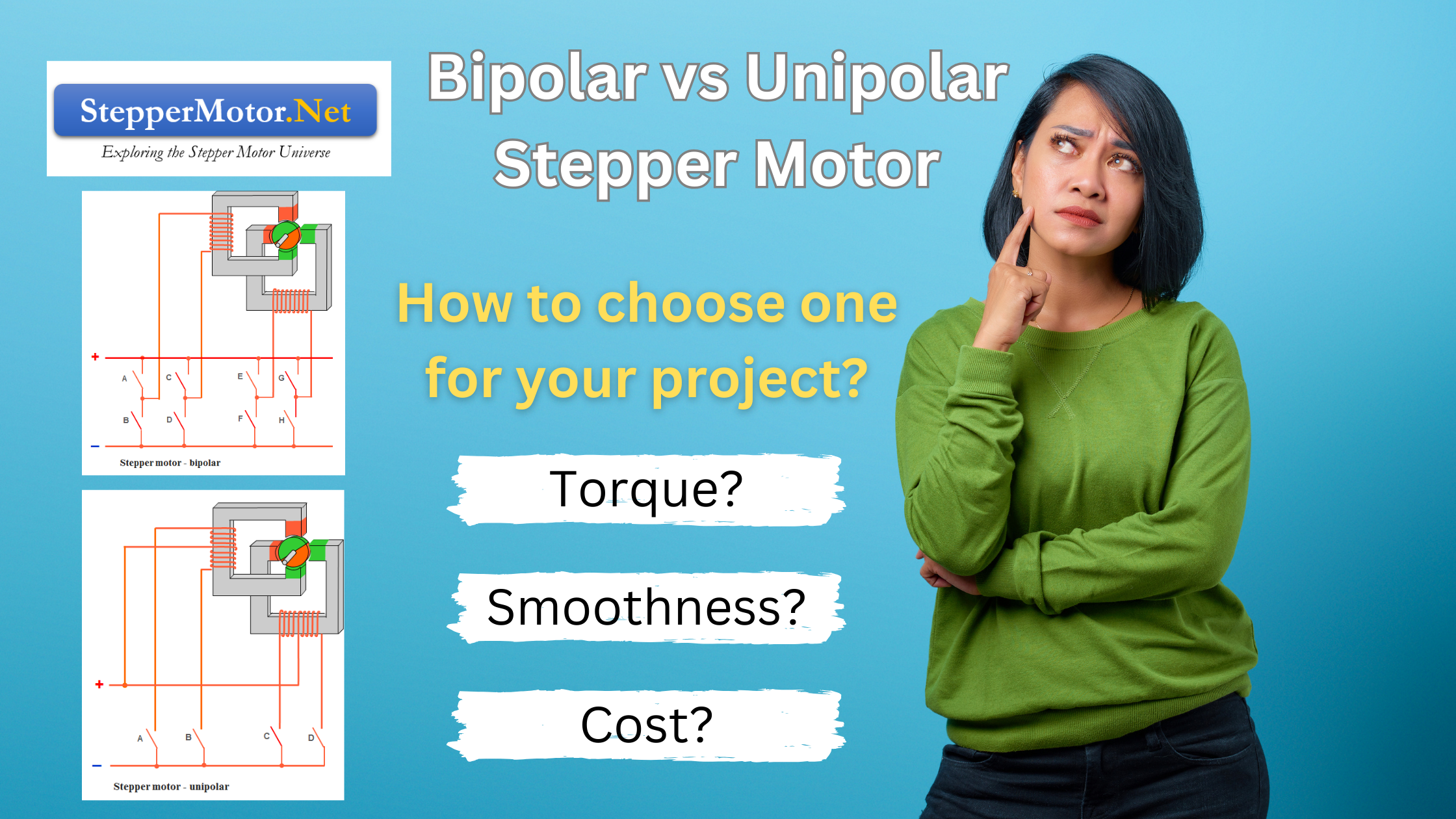Bipolar vs Unipolar Stepper Motor: Within the diverse world of stepper motors, two main styles take center stage, each with its own strengths and quirks: the bipolar and the unipolar. Choosing the right partner for your project depends on the dance you want them to perform.
Stepper Motors
A stepper motor is a type of electric motor that converts electrical pulses into discrete mechanical movements. Unlike conventional DC motors, which rotate continuously when a voltage is applied, stepper motors move in precise steps, with each step representing a fixed angular rotation. Stepper motors consist of a rotor and a stator, and their operation is characterized by the ability to control position and rotation accurately. If we categories the stepper motors then there are mainly two types of stepper motors – (i) Unipolar stepper motors and (ii) Bipolar stepper motors. In this article we are going to learn about these two types of stepper motors in detail and we will understand which one will suit and fulfill the requirement of any one’s project.
Bipolar Stepper Motors
A bipolar stepper motor is a type of stepper motor that has two magnetic poles or winding phases. In this motor configuration, the current flows through the winding in both directions, creating a magnetic field with both north and south poles. This creates a stronger magnetic field for each step, resulting in higher torque and smoother operation. The rotor of a bipolar stepper motor typically has a north and a south pole as well.
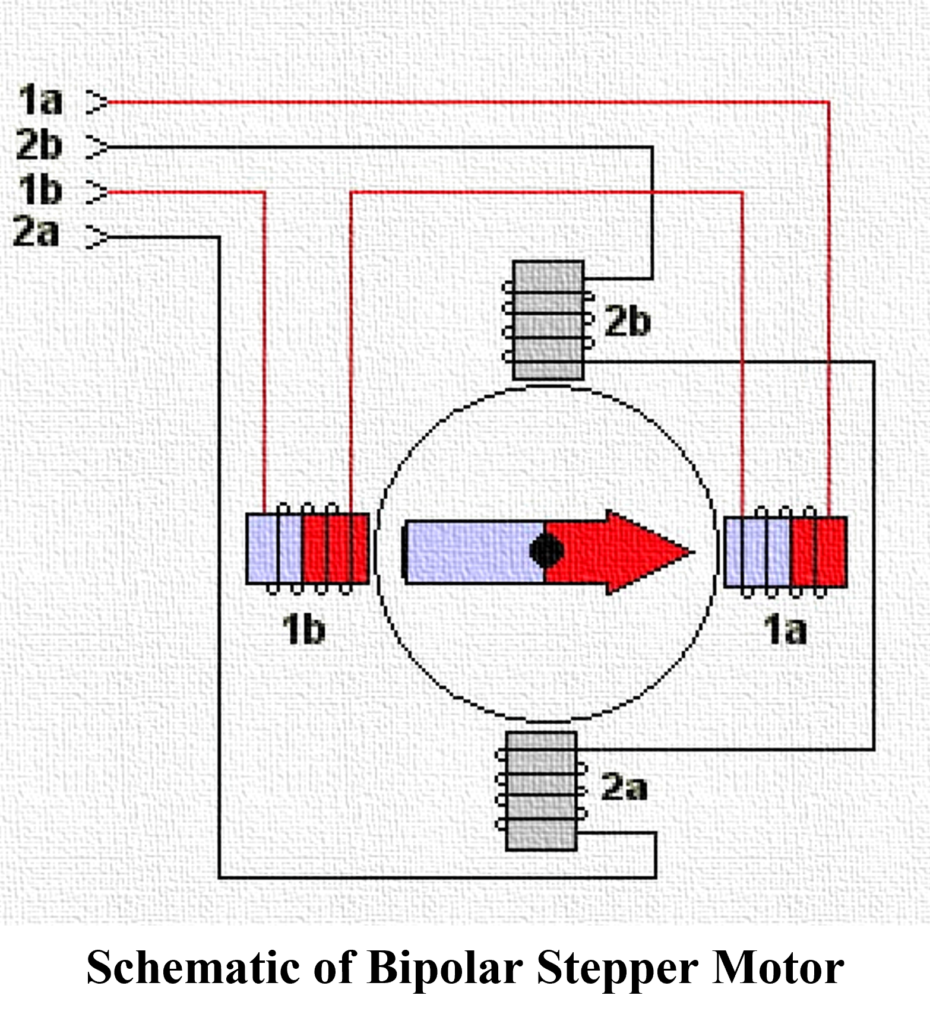
Characteristics of Bipolar Stepper Motor
The key characteristics of a bipolar stepper motor are given below:
- Two Coil Phases: The bipolar stepper motor has two coil windings or phases. These windings are usually energized in a sequence to generate a magnetic field that interacts with the rotor, causing it to move in discrete steps.
- Bidirectional Current Flow: Unlike unipolar stepper motors, which use center-tapped windings, bipolar stepper motors do not have a common center tap. Instead, the current flows through the windings in both directions.
- Full Steps and Microstepping: Bipolar stepper motors can operate in full-step mode, where each step corresponds to the activation of one coil phase, or in microstepping mode, where the current is varied to create intermediate steps, providing smoother motion and increased resolution.
- Simple Control Circuitry: The control circuit for a bipolar stepper motor is relatively straightforward compared to some other motor types. By energizing the two phases in the correct sequence, the motor can be precisely controlled.
- Higher Torque Density: Bipolar stepper motors often have a higher torque density compared to their unipolar counterparts, making them suitable for applications that require more torque in a compact form.
However, these bipolar stepper motors come with a limitation: complexity. Bipolar motors typically have four wires but can also have eight for microstepping configurations. They require more sophisticated drivers and slightly higher costs.
Unipolar Stepper Motors
hese motors have one coil per phase with a center tap connection. The current can only flow in one direction, requiring the use of a diode for each phase to reverse the field and achieve step movement. This results in lower torque and efficiency compared to bipolar motors. Unipolar motors typically have five or six wires. This design allows for simpler control circuitry compared to bipolar stepper motors. In a unipolar stepper motor, the current flows through each half of the coil separately, and by energizing the coils in a specific sequence, the motor can be made to step in a precise manner.
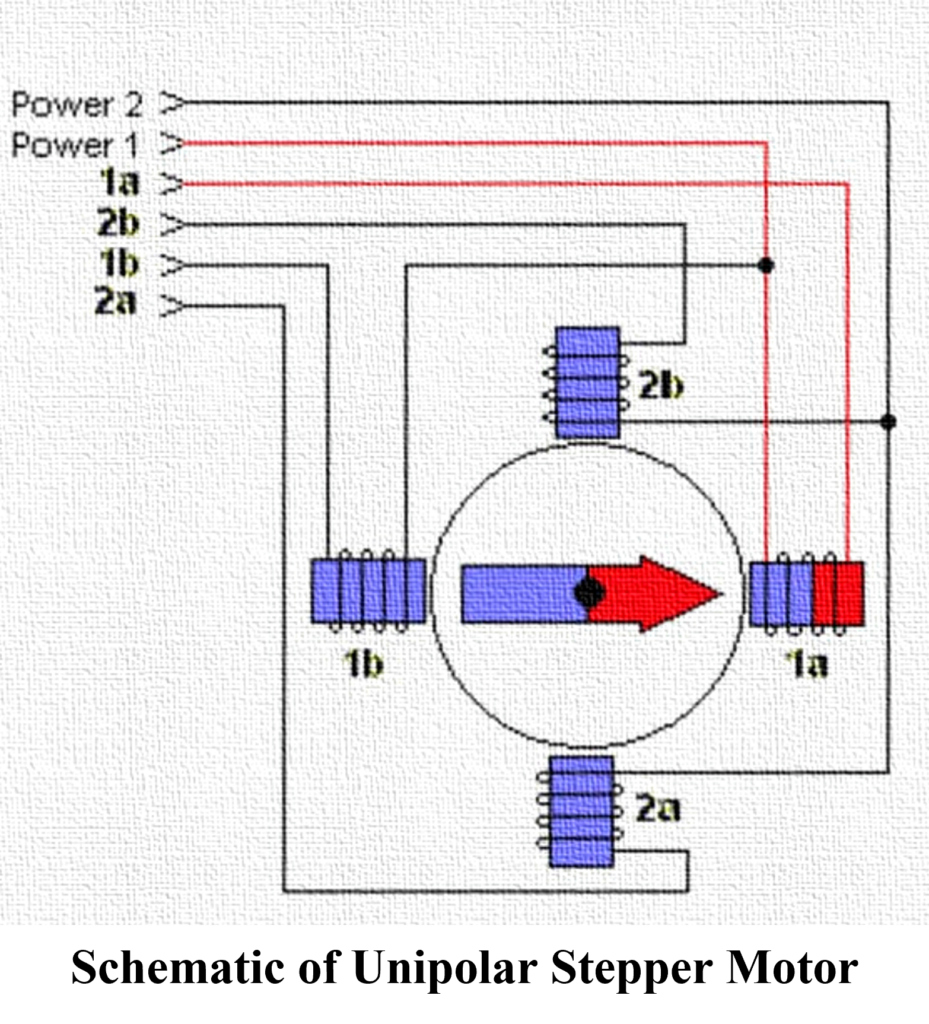
Characteristics of Unipolar Stepper Motor
The key characteristics to identify a unipolar stepper motor are given below:
- Four-Coil Wires: Unipolar stepper motors have four wires, each corresponding to a different coil or winding. The coils are center-tapped, meaning there is a connection at the center of each coil.
- Easier Control Circuitry: Unipolar stepper motors are generally easier to control than bipolar motors because each coil can be powered independently. This simplifies the control circuitry and makes them more accessible for certain applications.
- Limited Torque Density: Unipolar stepper motors often have lower torque density compared to bipolar motors. However, advancements in technology and design have improved the performance of unipolar stepper motors in recent years.
- Commonly Used in Low-Cost Applications: Unipolar stepper motors are frequently used in applications where cost is a significant factor. They are found in various consumer electronics, printers, and other devices where precise control and high torque are not the primary requirements.
- Open-Loop Control: Like bipolar stepper motors, unipolar stepper motors are often operated in an open-loop control system, meaning there is no feedback mechanism to confirm the actual position of the motor.
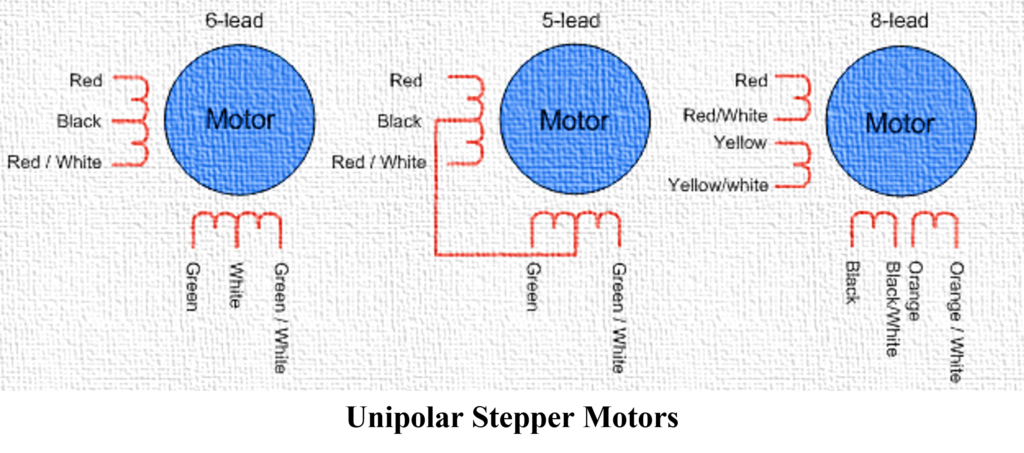
Bipolar vs Unipolar Stepper: Key Differences
Choosing the right stepper motor for your project can be a daunting task. To help you out, here’s a comprehensive table comparing key features of bipolar and unipolar motors:
| Feature | Bipolar Motor | Unipolar Motor |
| Coil Configuration | Head-to-tail configuration in each phase (2 coils per phase) | Single coil per phase with a center tap |
| Wires | 4 (2 per phase) | 5 (3 center tap wires, 2 main leads) |
| Current Flow | Alternating, with one coil energized at a time | Flipping magnetic field by switching current flow through center tap |
| Torque | High – can handle heavy loads | Moderate – suitable for lighter tasks |
| Efficiency | Lower due to higher coil resistance | Higher due to simpler design |
| Smoothness | Smoother, less cogging due to balanced magnetic pull | Slightly less smooth, some cogging possible |
| Cost | Higher due to more complex design and drivers | Lower – cost-effective option for beginners |
| Driver Complexity | More complex and expensive drivers required for microstepping | Simpler and less expensive drivers, some basic microstepping options available |
How to Choose the Right Stepper Motor?
Bipolar vs Unipolar Stepper: Choosing the right stepper motor for your project feels like selecting a dance partner for a complex performance. Each motor type, like a skilled dancer, excels in certain areas, and understanding their distinct styles is crucial for a successful partnership. To help you navigate this captivating stage, let’s explore deeper into the key features of bipolar and unipolar stepper motors, exploring their significance and impact on your project considerations.
Bipolar vs Unipolar Stepper: Coil Configuration
As a bipolar motor, boasting two coils per phase nestled within the stator in a head-to-tail configuration, with opposite magnetic poles when energized, creating pulling and releasing forces on the rotor for each step. In contrast, a unipolar motor is utilizing only one coil per phase with a clever center tap, like a hidden partner, to reverse the current flow and pull the rotor in the opposite direction.
Significance of Coil Configuration for Project Considerations
- Bipolar Coil Configuration: Offers higher torque due to balanced magnetic pull from both coils, ideal for handling heavy loads in 3D printers and CNC machines. Requires more complex drivers for advanced control.
- Unipolar Coil Configuration: Simpler design makes it easier to work with, suitable for beginners and basic projects like hobby robots. May have lower torque and require additional center tap connections.
Bipolar vs Unipolar Stepper: Wires
Bipolar motors, with their duet of coils, require four wires, two for each phase. Imagine two pairs of invisible strings guiding the dancers’ movements. Unipolar motors, on the other hand, have a solo act with a twist, necessitating five wires. Three center tap wires provide flexibility in current flow direction, while two main leads carry the electrical baton.
Significance of Wires for Project Considerations
- Bipolar Wires: More wires can mean higher cost and slightly increased wiring complexity. Requires compatible bipolar drivers with four channels.
- Unipolar Wires: Fewer wires make them cost-effective and easier to connect. Utilizes simpler unipolar drivers, often with fewer channels but potentially limited advanced features.
Bipolar vs Unipolar Stepper: Current Flow
Bipolar motors showcase an elegant alternating current flow, with one coil energized at a time. In contrast, unipolar motors rely on a clever magnetic field flip achieved by switching current flow through the center tap.
Significance of Current Flow for Project Considerations
- Bipolar Current Flow: Enables sophisticated microstepping techniques for ultra-precise movements in high-resolution 3D printing and scientific instruments. Requires drivers capable of managing complex current patterns.
- Unipolar Current Flow: Simpler current flow and center tap manipulation limit advanced control options. Can still achieve basic microstepping for smoother motion but with potentially lower resolution.
Bipolar vs Unipolar Stepper: Torque
Bipolar motors reign supreme in terms of torque, boasting unparalleled pulling power thanks to their balanced magnetic forces. Consider them the weightlifters of the stepper motor world, ideal for demanding applications like CNC machines and robotic arms. In contrast, unipolar motors pack a less powerful punch, offering moderate torque suitable for lighter tasks such as animating puppets or controlling pick-and-place mechanisms.
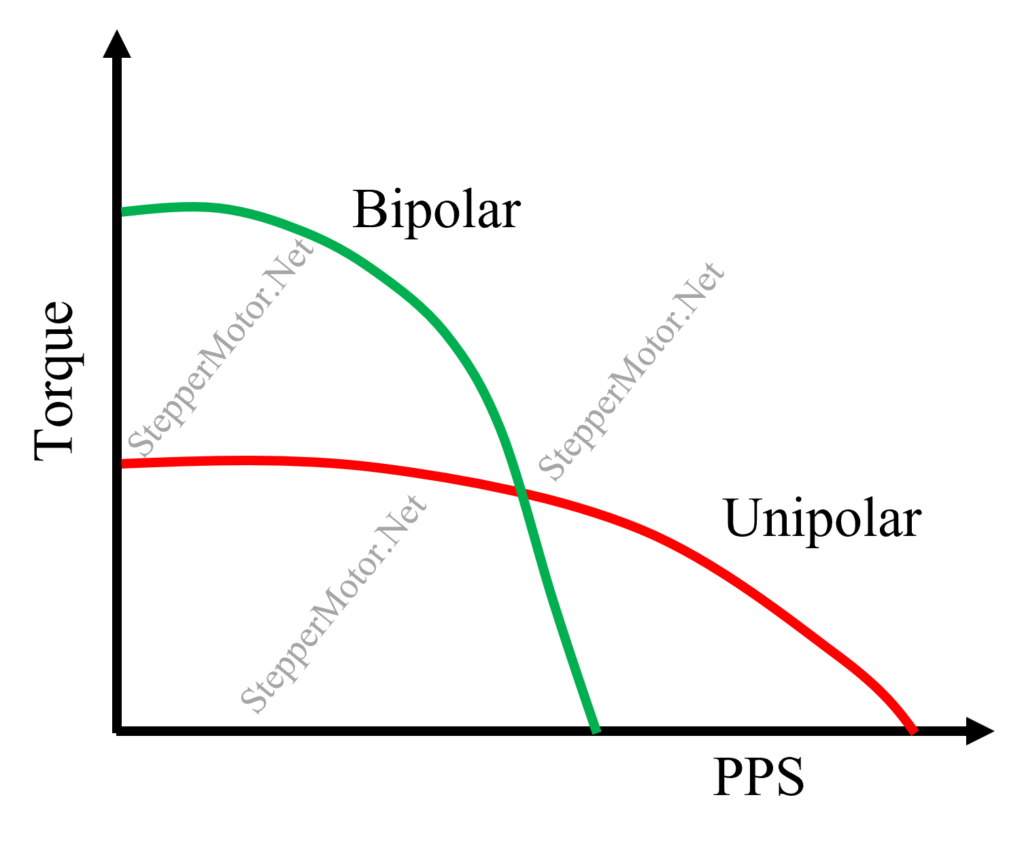
Significance of Torque for Project Considerations
- Bipolar Torque: Ideal for projects requiring high precision and handling heavy loads. May require robust drivers and larger motors, leading to higher costs.
- Unipolar Torque: Sufficient for simpler projects where lower load capacities are acceptable. Cost-effective option for applications where high torque isn’t a primary concern.
Bipolar vs Unipolar Stepper: Efficiency
The optimal energy utilization, and efficiency plays a crucial role in stepper motors. Bipolar motors, while powerful, have lower efficiency due to their higher coil resistance. Unipolar motors, with their simpler design, boast higher efficiency. Think of them as graceful performers, utilizing less energy for each step.
Significance of Efficiency for Project Considerations
- Bipolar Efficiency: May require larger power supplies and generate more heat due to lower efficiency. Consider thermal management and energy consumption for extended operation.
- Unipolar Efficiency: More efficient operation translates to potentially smaller power supplies and reduced heat generation.
Bipolar vs Unipolar Stepper: Smoothness
Stepper motors strive for smoothness in their rotations, minimizing jarring jerks and cogging. Bipolar motors, with their synchronized coil transitions, excel in this aspect, offering superior smoothness and near-silence operation. This makes them ideal for applications like high-resolution 3D printing and medical scanners where precise and delicate movements are essential. In contrast, unipolar motors, due to their single-coil design and center tap flips, may exhibit some cogging, especially at low speeds. However, advanced unipolar drivers can implement microstepping techniques to improve smoothness, albeit not reaching the finesse of their bipolar counterparts.
Significance of Smoothness for Project Considerations
- Bipolar Smoothness: Essential for applications demanding precise, jerk-free movements and quiet operation. May require more expensive drivers and sophisticated motor control protocols.
- Unipolar Smoothness: Sufficient for most basic projects where slight cogging is acceptable. Cost-effective option but may limit applications requiring absolute precision and smoothness.
Bipolar vs Unipolar Stepper: Cost
Every project has a constrain of budget. Bipolar motors, with their complex design, advanced features, and powerful drivers, come at a higher cost. Unipolar motors, on the other hand, are the accessible performers, offering lower cost due to their simpler design and drivers; perfect for beginners and budget-conscious projects.
Significance of Cost for Project Considerations
- Bipolar Cost: Higher initial investment in motor and driver but may offer long-term benefits in terms of performance and capabilities. Evaluate project requirements and potential return on investment.
- Unipolar Cost: Cost-effective entry point for experimentation and simple projects. May limit options for demanding applications requiring high torque, smoothness, or advanced control.
Bipolar vs Unipolar Stepper: Driver Complexity
Every dance needs a skilled conductor, and for stepper motors, this role falls on the driver. Bipolar motors, with their intricate current flow patterns and microstepping techniques, require more complex and expensive drivers. These drivers act like maestros, meticulously managing the electrical symphony to achieve precise control and advanced features. Unipolar motors, with their simpler current flow, work with less complex and cheaper drivers.
Significance of Cost for Project Considerations
- Bipolar Driver Complexity: Requires careful driver selection based on desired control features and microstepping resolution. May need additional hardware and software configuration.
- Unipolar Driver Complexity: Easier to choose drivers due to simpler functionality. Often plug-and-play options available, requiring minimal configuration.
Beyond the Features: Choosing the Perfect Stepper Motor for Your Project
Understanding these key features is just the first step for expertise in stepper motors. Remember, the ideal partner for your project depends on a nuanced waltz of factors:
- Project Requirements: Identify the specific needs of your project, considering factors like torque, smoothness, precision, speed, and budget.
- Skill Level: Are you a seasoned engineer or a curious beginner? Choose a motor and driver complexity that matches your expertise and comfort level.
- Long-Term Vision: Consider if your project might evolve in the future, and select a motor with upgrade potential or flexibility for modifications.
Now that we’ve met the captivating performers of the stepper motor world, it’s time to choose the ideal partner for your project. Here’s a step-by-step guide to navigate the dance:
1. Define Your Project’s Needs: What is your project about? Does it require high torque for intricate 3D printing? Smooth, silent movements for robotics or scientific instruments? Answering these questions will guide your initial selection.
2. Consider the Load: Will your motor be handling heavy objects or delicate tools? Bipolar motors, with their superior torque, might be the better choice for demanding tasks.
3. Prioritize Precision: Does your project require near-infinitesimal movements or can it tolerate slight jerks? If absolute precision is key, bipolar motors with advanced micro-stepping options might be your best bet.
4. Budget Matters: Are you starting with a limited budget or willing to invest for long-term performance? Unipolar motors are the cost-effective entry point, while hybrids offer a balance between affordability and advanced capabilities.
5. Embrace Experimentation: Don’t be afraid to try different options! Unipolar motors can be a great starting point to learn the basics, while hybrids provide a stepping stone towards the precision of bipolar motors.
Conclusion
In this article – Bipolar vs Unipolar stepper motor, we have discussed the basics of bipolar and unipolar stepper motor and their key characteristics. We have also studied the key differences between these two types of stepper motors. Along with the difference between bipolar and unipolar stepper motor, we also learned how to choose a perfect stepper motor for our project. I hope this information will be beneficial for you and it will help you in your studies and to complete your projects.

